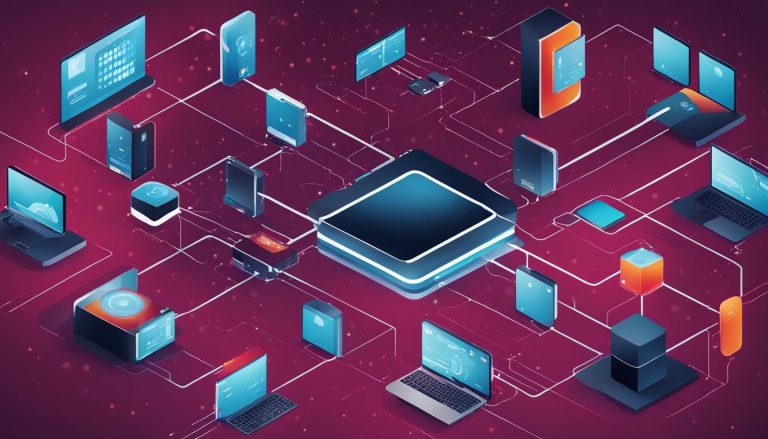Welcome to the world of debugging! As a programmer or engineer, you have probably encountered errors in your code that have left you scratching your head. That’s where debugging comes in. Debugging is a crucial process in computer programming and engineering that helps identify and resolve code errors or hardware component issues. It is an essential part of the software testing and development lifecycle.
From the moment you start writing code to when it is combined with other programming units to form a software product, debugging plays a vital role. But what exactly does it entail? Debugging involves not only locating the source of a problem but also reproducing it for analysis. It requires using various methods and techniques to pinpoint and fix errors in software programs.
Key Takeaways:
- Debugging is the process of identifying and resolving code errors or hardware component issues.
- It is an essential part of the software testing and development lifecycle.
- Debugging involves locating and reproducing problems to analyze and fix them.
- There are various methods, tools, and techniques available for debugging software programs.
- The purpose of debugging is to improve software quality and ensure a better end-user experience.
How Debugging Works in Software
In the world of software development, debugging plays a crucial role in identifying and resolving coding errors. Understanding how the debugging process works is essential for developers to effectively troubleshoot and enhance their code.
One of the primary steps in debugging is the identification of code errors. Developers can analyze the code’s logging to gain insights into the flow of execution and pinpoint potential problem areas. Additionally, they can utilize standalone debugger tools or leverage the debug mode of an integrated development environment (IDE). These tools provide a comprehensive set of features that allow developers to step through their code, set breakpoints, and inspect variables to understand the behavior of their program.
Standard error messages are also valuable resources in the debugging process. These messages provide information about the specific error encountered, helping developers narrow down the root cause of the issue. By understanding the meaning behind these messages, developers can efficiently debug their code and implement the necessary fixes.
Another valuable debugging strategy is the use of unit tests. Unit tests, such as JUnit and xUnit, enable developers to run specific functions with predefined inputs and compare the expected output with the actual result. This approach helps isolate issues within individual components of the code and facilitates targeted debugging. Developers can also employ techniques like setting up breakpoints, using memory views, and inspecting variables during runtime to gain deeper insights into their code’s behavior.
| Debugging Process | Unit Tests | Code Logging | Debug Mode | Standard Error Messages |
|---|---|---|---|---|
| Identification of code errors | Run specific functions with predefined inputs | Analyze the code’s logging | Utilize standalone debugger tools or IDE’s debug mode | Provides information about specific errors encountered |
| Reproduction of errors for analysis | Compare expected output with actual result | |||
| Breakpoints, memory views, and variable inspection |
Importance of Debugging
Debugging plays a vital role in the software development lifecycle by addressing software misbehavior and resolving software bugs. Despite following coding standards, it is inevitable that new software programs will have bugs. These bugs can lead to unexpected behavior, system crashes, or security vulnerabilities. Debugging is crucial for locating and fixing these issues, ensuring that the software functions as intended.
Software misbehavior can have significant consequences, affecting user experience, productivity, and even the reputation of the software or company. Debugging allows developers to identify and address these issues, improving the overall quality and functionality of the software. By eliminating bugs, developers can provide a more reliable and stable product to end-users.
The process of debugging involves analyzing code, identifying the source of the problem, and implementing fixes. It requires careful attention to detail, problem-solving skills, and a thorough understanding of the software being developed. Debugging should be an integral part of the development process, starting from the initial coding phase and continuing throughout the software’s lifecycle.
The Importance of Debugging in the Software Development Lifecycle
Debugging is not just an isolated task; it is an essential component of the software development lifecycle. It helps catch errors early on, preventing them from propagating into later stages of development. By identifying and resolving bugs as soon as possible, developers can save time and resources that would otherwise be spent on extensive troubleshooting and rework.
Furthermore, debugging helps maintain code quality and facilitates collaboration among team members. By thoroughly testing and debugging software, developers ensure that the codebase is clean, reliable, and easier to maintain. It also promotes efficient teamwork, as issues are identified and resolved promptly, minimizing bottlenecks and delays in the development process.
| Benefits of Debugging | Challenges of Debugging |
|---|---|
|
|
Debugging is not just about fixing bugs; it is about ensuring the reliability and functionality of software applications. By investing time and effort in debugging, developers can create better products that meet customer expectations and provide a seamless user experience. It is an essential practice that should be prioritized throughout the software development process.
Debugging vs. Testing
In the world of software development, debugging and testing are two essential processes that work hand in hand to ensure the quality and reliability of a software program. While testing focuses on identifying mistakes in the program’s source code and understanding their effects, debugging takes it a step further by locating and fixing these mistakes. In other words, testing reveals the symptoms of an error, while debugging dives deep into the root cause.
Identifying coding mistakes: When it comes to testing, the primary goal is to identify any coding mistakes or errors in the software program. This involves running the program with different inputs and scenarios to observe how it behaves. Testing alone can help detect issues, but it may not provide the specific details about the coding mistake responsible for the error.
Locating and fixing errors: Debugging, on the other hand, is crucial for locating and fixing these coding errors. It involves a systematic approach of analyzing the code, setting up breakpoints, and utilizing debugging tools to identify the precise cause of the error. Once the root cause is identified, developers can implement the necessary fixes to resolve the issue.
Both testing and debugging play vital roles in the software development process. While testing helps ensure that a software program meets the desired requirements and functions as expected, debugging allows developers to dig deeper into the code to identify and resolve any issues that arise. Together, these processes contribute to the overall quality and reliability of the software program.
| Debugging | Testing |
|---|---|
| Focuses on locating and fixing coding errors | Focuses on identifying mistakes in the source code |
| Requires in-depth analysis and utilization of debugging tools | Requires running the program with different inputs and scenarios |
| Helps identify the root cause of errors | Reveals the symptoms and effects of errors |
| Ensures a more robust and reliable software program | Ensures the software meets desired requirements |
Common Coding Errors and Debugging Strategies
When it comes to programming, it’s not uncommon to encounter various coding errors that can hinder the proper functioning of a software program. These errors can range from simple syntax mistakes to more complex logic errors that affect the program’s behavior. Understanding these common coding errors and having effective debugging strategies in place is crucial for developers to ensure the smooth operation of their software.
Syntax Errors
One of the most basic coding errors is a syntax error, which occurs when the programmer makes a mistake in the language syntax. This can be as simple as a missing semicolon or a misplaced parenthesis. These errors are usually detected by the compiler or interpreter and prevent the code from running correctly. To fix syntax errors, developers need to carefully review their code for any mistakes in the syntax and make the necessary corrections.
Runtime Errors
Runtime errors occur while a program is executing and are often caused by issues such as division by zero or accessing memory that has not been properly allocated. These errors can lead to program crashes or unexpected behavior. To debug runtime errors, developers can use debugging tools that allow them to trace the program’s execution and identify the specific line of code causing the error. By pinpointing the source of the error, developers can then devise a solution to fix it.
Semantic Errors
Semantic errors occur when the program’s logic is flawed, resulting in incorrect program behavior. These errors can be more challenging to identify as they do not cause the program to crash or display error messages. Instead, they cause the program to produce incorrect outputs or behave in unexpected ways. To debug semantic errors, developers need to carefully analyze their code’s logic and verify that it adheres to the intended behavior. Debugging strategies such as print statements or stepping through the code line by line can be helpful in identifying and resolving these errors.
Logic Errors
Logic errors occur when the program’s logic is implemented incorrectly, leading to unintended results. These errors are often the most difficult to track down because they do not produce error messages or crash the program. Developers need to carefully review their code to identify any discrepancies between the intended logic and the actual implementation. Debugging strategies for logic errors include using debugging tools that allow developers to inspect variable values and step through code execution to identify where the logic deviates from the expected behavior.
| Error Type | Description | Debugging Strategy |
|---|---|---|
| Syntax Error | An error in the language syntax | Carefully review code for syntax mistakes |
| Runtime Error | An error that occurs during program execution | Use debugging tools to trace and identify the error |
| Semantic Error | An error in the program’s logic | Review code logic and use debugging strategies |
| Logic Error | An error in the implementation of the program’s logic | Inspect code and use debugging tools to identify discrepancies |
By being aware of these common coding errors and utilizing effective debugging strategies, developers can efficiently identify and resolve issues in their software programs. Debugging plays a vital role in ensuring the functionality and reliability of software, ultimately leading to a better user experience and satisfaction.
Debugging Tools
When it comes to debugging software, developers have a range of powerful tools at their disposal. These tools are designed to help identify and resolve coding errors efficiently, saving time and effort in the debugging process. Let’s take a look at some of the most commonly used debugging tools.
Debugger
A debugger is an essential tool for any developer when it comes to pinpointing and fixing code errors. It allows programmers to step through their code line by line, inspecting variables and data values in real-time. This enables them to track down the exact source of the problem and test potential solutions. With a debugger, developers can gain valuable insights into how their code is executing and make targeted fixes.
Test Run Analysis
Test run analysis tools help developers analyze the behavior of their code during different test scenarios. These tools provide detailed reports on the execution flow, highlighting any discrepancies or unexpected outcomes. By examining test run data, developers can identify patterns and trends that may indicate the presence of bugs or errors. This information can then be used to guide the debugging process and ensure that all issues are properly addressed.
Simulators
Simulators are widely used in software development to mimic the behavior of specific operating systems or devices. By running an application on a simulator, developers can test its functionality and performance in a controlled environment. This allows them to identify and fix any code errors that may arise when the application is deployed on different platforms. Simulators provide a valuable testing ground for developers to fine-tune their code and ensure it works seamlessly across a variety of devices.
USB Debugging
USB debugging is a feature commonly used in Android development. It enables developers to establish a direct connection between their computer and an Android device. This connection allows for real-time debugging, where developers can monitor their code’s execution on the device and detect any issues that may occur. USB debugging is particularly useful when testing mobile applications or troubleshooting device-specific problems.
These are just a few examples of the many debugging tools available to developers. By leveraging these tools effectively, programmers can streamline the debugging process and ensure their code is free from errors. Whether it’s using a debugger to analyze code execution, employing test run analysis tools to identify discrepancies, or utilizing simulators to test on different platforms, these debugging tools are instrumental in creating high-quality software.
Challenges of Debugging
Debugging is an essential part of the software development process, but it can also be a challenging and time-consuming task. One of the main challenges developers face is identifying the cause of a coding error. Sometimes, the root cause of the problem is not immediately apparent, requiring thorough analysis and investigation. This process can be especially difficult when dealing with complex software systems that involve multiple modules and dependencies.
Another challenge in debugging is reproducing elusive errors. Some bugs only occur under specific circumstances or in certain scenarios, making them difficult to reproduce consistently. This can make it challenging to pinpoint the exact conditions that lead to the error and understand its underlying cause.
Managing dependencies is also a common challenge in debugging. Software systems often rely on various external libraries, APIs, or other components. If these dependencies are not clearly defined or well-documented, fixing one error may unintentionally introduce new errors in other parts of the program. Managing and resolving these dependencies requires careful coordination and thorough testing to ensure that changes do not have unintended consequences.
Summary:
- Identifying the cause of a coding error can be challenging, requiring thorough analysis and investigation.
- Reproducing elusive errors that occur in specific scenarios can be difficult, making it challenging to understand the underlying cause.
- Managing dependencies in software systems is crucial, as fixing one error may unintentionally introduce new errors in other parts of the program.
Conclusion
After understanding the basics of debugging, it is clear that it plays a crucial role in software development. To become an effective debugger, there are some important tips and best practices to keep in mind.
Firstly, writing clean and concise code is essential. By following coding standards and conventions, developers can minimize the occurrence of bugs. Additionally, proper error handling techniques should be implemented to gracefully handle exceptions and prevent crashes.
Furthermore, utilizing debugging tools such as IDE debuggers and code analyzers can significantly expedite the debugging process. These tools provide valuable insights into the code execution flow, allowing developers to pinpoint specific issues quickly.
In conclusion, debugging is an integral part of software development. By employing effective debugging tips, adhering to best practices, and leveraging appropriate tools, developers can identify and resolve coding errors efficiently. This enhances software quality, improves the end-user experience, and ultimately contributes to the success of the development process.
FAQ
What is debugging?
Debugging is a process in computer programming and engineering that involves identifying and resolving code errors or hardware component issues.
Why is debugging important in software development?
Debugging is necessary to locate and fix bugs in software programs, ensuring software quality and a better end-user experience.
What are the common challenges in debugging?
Common challenges in debugging include identifying the source of a problem and reproducing it for analysis.
How can I debug my code?
Debugging strategies include using unit tests, code reviews, and debugging tools like debuggers, log analysis, and memory views.
What are the common coding errors?
Common coding errors include syntax errors, runtime errors, semantic errors, and logic errors.
What are some useful debugging tools?
Debugging tools include debuggers, simulators, and USB debugging for Android devices.
How do I handle elusive errors that occur sporadically?
Reproducing elusive errors can be a challenge, but utilizing debugging tools, analyzing error messages, and following best practices can help.
What are some best practices for debugging?
Best practices include writing clean and concise code, using proper error handling techniques, and leveraging debugging tools provided by integrated development environments (IDEs).
Janina is a senior specialist in information technology


